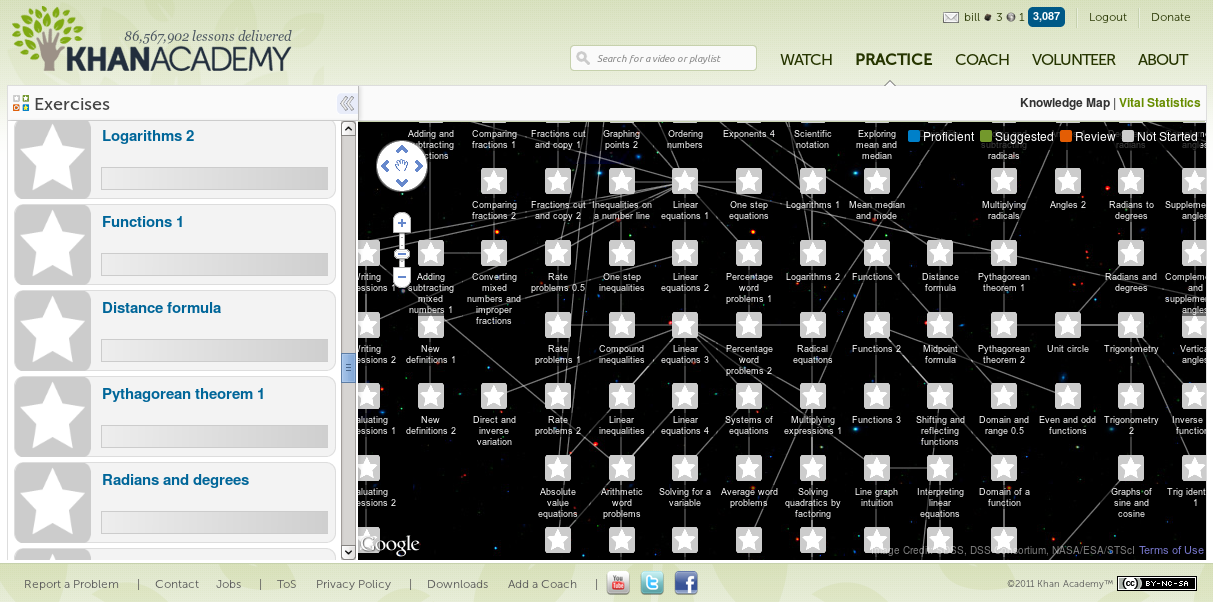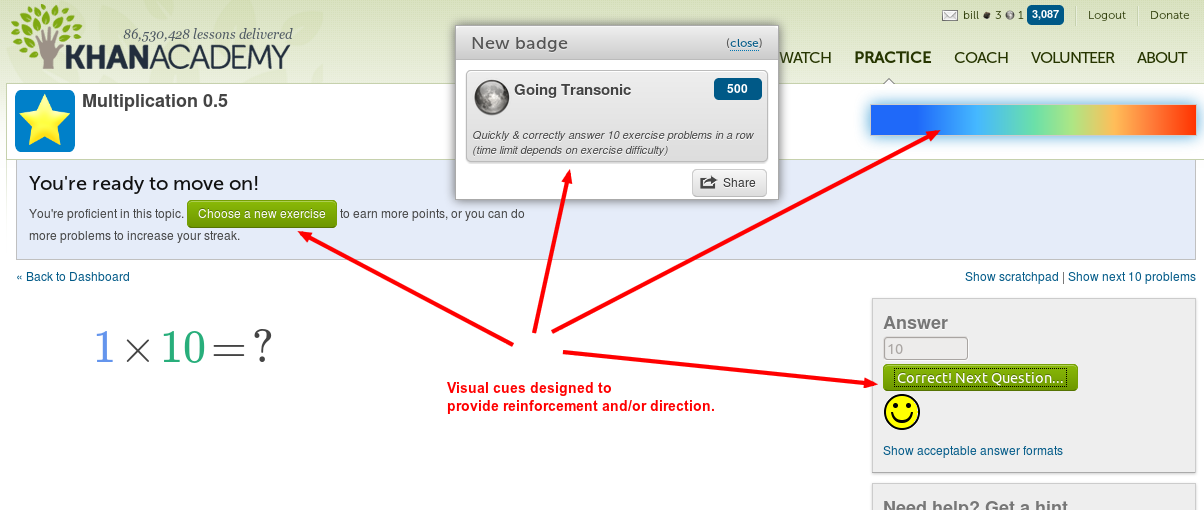Khan Academy: Data, Design, and Open Content
5 min read
It's pretty safe to say that Khan Academy arouses strong feelings; one of the barriers in appreciating what Khan Academy actually delivers is how Khan Academy is typically described. However, the conversations about Khan Academy often get bogged down in the goals and plans for the growth of Khan Academy, as opposed to how Khan can be used. In this post, I want to start with the basics: the elements of Khan Academy that are highlighted within the user interface (UI).
The basic premise of Khan - as reflected in the UI - is all about streamlining time on task, as defined by watching videos and working through problem sets.
The dashboard that measures student progress hews closely to these defined goals. A person can see how much time they have spent watching videos, working on problem sets, and how effective they have been at working through these problem sets.
The curriculum is organized into a series of related problem sets, and people can see their progress reflected in the overall scope and sequence, or as part of the grid that ties the quizzes together within a curricular scope.
The game mechanics keep the focus on working within the confines of the site, with students being rewarded for time on task, and for getting questions right. These game mechanics are baked into a student's work on the site; as a student works on problems, windows pop up and inform them that they can move on to a new exercise, or that they have earned a badge.
From the 30,000 foot view, Khan Academy appears to have given people a means to track progress across computerized tests, with tutorial videos provided to give background on a subject. As part of the package, teachers can monitor the work of their students; in the language used within the Khan Academy UI, this is called "coaching."
What's missing, of course, is any comparable emphasis on open ended thinking, or of problem solving that goes beyond quizzes that have a clear right or wrong answer. Also, while participants have the freedom to chart their own course through the video collection, the fact that people can choose their own path through a large set of videos does not change the fact that - from the perspective of an individual learner - a video collection, no matter how large, no matter how often the videos can be rewound and rewatched, is still just a video collection.
As others have noted, the pedagogical strategy of Khan Academy isn't new, despite the energy and zeal of people proclaiming the arrival of the “flipped classroom.†The notion of providing quality resources to students for asynchronous use outside of class -- and using class time for higher level problem solving, collaboration, and student-led inquiry -- feels pretty familiar to a lot of teachers, despite the fact that many bloggers, pundits, and policymakers seem to be stumbling upon the ideas only recently.
But Khan Academy delivers on two things, better than anything or anyone else has to date. First, the existence of the dashboard within the Khan Academy app has the potential to transform the way educators think about using and accessing data on student progress. The dashboard within Khan Academy is, at this writing, limited by what Khan Academy tracks - time on task, correct and incorrect answers on quiz problems - but even that limited info gives teachers (or "coaches," in KA-speak) the ability to help students in a more timely way. When I see the dashboard in place in KA, I imagine how much more effective a teacher could be if the dashboard was itself an opportunity for interaction between learners - what if, for example, a student could flag that they were stuck on a rough draft, or on a lab, or in using physics as a tool to improve their communities? Expanding the scope of what people can interact about is, at its core, a design issue. The data is there, but simple means to visualize and interact around that data are in short supply. The tools within Khan Academy provide a good starting point for conversations about the value of design within education.
The second thing that Khan has made more accessible is the value of openly licensed educational resources. All material on Khan Academy is licensed under a Creative Commons Non-Commercial license, which ensures that these resources, and any subsequent improvements, will remain freely available. Because of the enormous generosity of Salman Khan, and the resources he has marshalled into this effort, the world now has an enormous body of good quality material that can be used to learn about a broad range of subjects. The body of material within Khan Academy can be used to replace large sections of traditional textbooks. The support of high-visibility donors has given these resources a credibility that other openly licensed materials, for whatever reason, have never enjoyed. Salman Khan's effort and vision in building a large body of openly licensed material has shifted the way people think about open content. Partnerships with SmartHistory, and the plans to include community-created material within Khan Academy, will widen the breadth of content within Khan Academy, while ensuring that this new material remains freely available, freely modifiable, and freely reusable in perpetuity. Potentially, Khan Academy will be accessible enough that people will realize that textbooks provided by the publishing industry are an unnecessary expense we can all live without.





